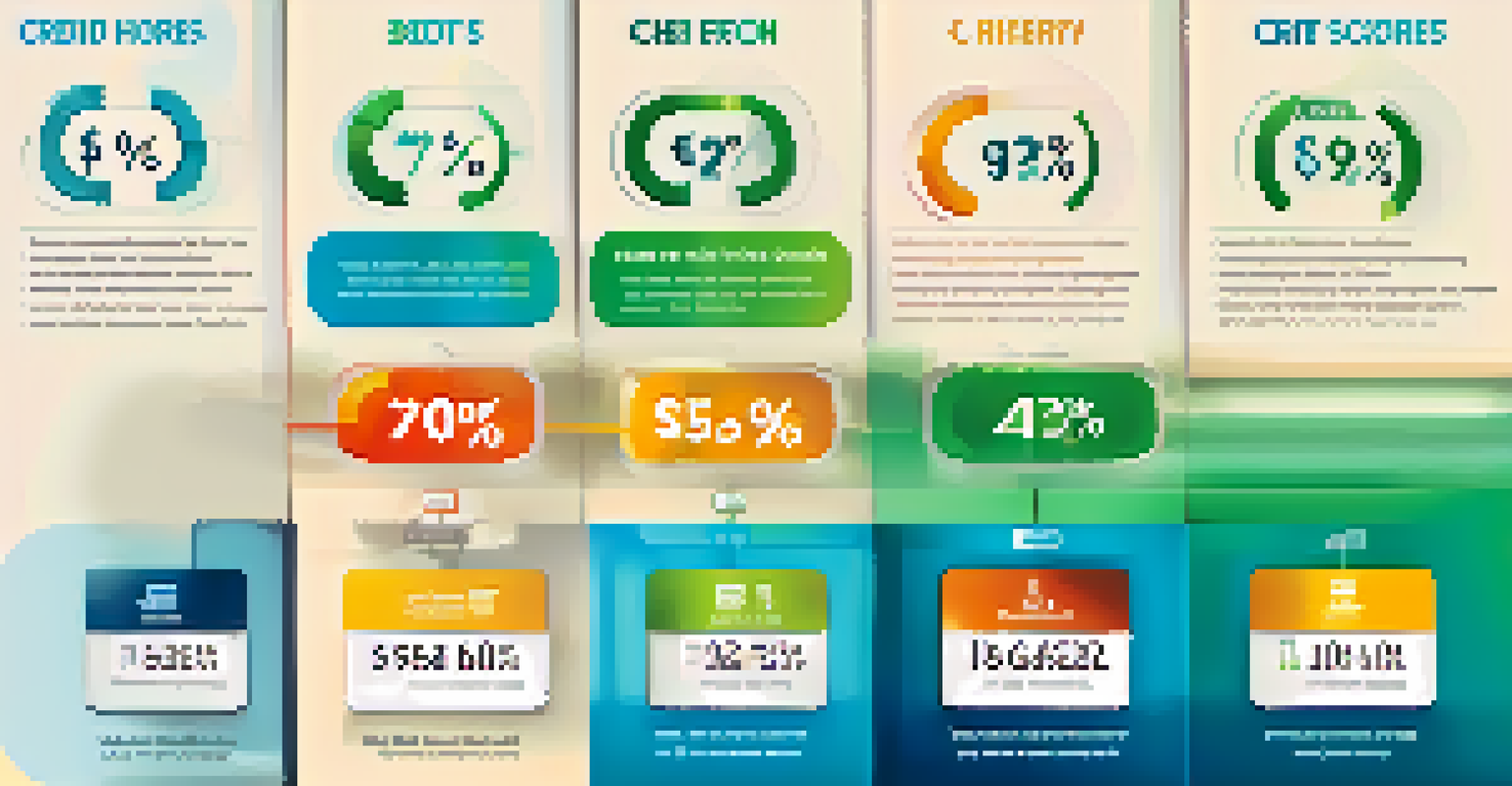Understanding the Different Types of Credit Scores

What is a Credit Score and Why Does it Matter?
A credit score is a numerical representation of your creditworthiness. It helps lenders assess the risk of lending you money, based on your credit history. Generally, the higher the score, the more favorable terms you can expect when applying for loans or credit.
A credit score is like a report card for your financial habits.
Your credit score can affect not only loan approval but also the interest rates you'll be charged. For instance, a score of 750 or above usually qualifies you for lower rates, while a score below 600 may lead to higher rates or even denial. This can have a significant impact on your financial life, from buying a home to getting a car loan.
Understanding your credit score is crucial because it empowers you to make informed financial decisions. Regularly monitoring your score can help you spot errors or identify areas for improvement, leading to better financial opportunities in the long run.
The Three Major Credit Reporting Agencies Explained
In the United States, three primary credit reporting agencies—Equifax, Experian, and TransUnion—collect and maintain your credit information. Each agency may have slightly different data, resulting in variations in your credit scores. It's essential to know which agency's score lenders are using, as it can influence your loan approval.

These agencies gather information from various sources, including credit card companies, banks, and public records. They compile this data into your credit report, which is then used to calculate your credit score. Because of this, it’s a good practice to check your credit report from all three agencies regularly.
Understanding Credit Scores Matters
A credit score reflects your creditworthiness and influences loan approvals and interest rates.
Understanding how each agency reports your credit can help you identify discrepancies and resolve them. By maintaining a good relationship with these agencies, you can ensure that your credit history reflects your true financial behavior.
FICO Score: The Most Common Credit Score Type
The FICO score, developed by the Fair Isaac Corporation, is the most widely used credit score in the U.S. Ranging from 300 to 850, this score considers factors like payment history, credit utilization, and length of credit history. Most lenders rely on FICO scores when evaluating credit applications, making them a key player in your financial journey.
Your credit score is a reflection of your financial life; it’s important to understand it to make informed choices.
For example, a FICO score above 700 is generally considered good, while scores below 600 are deemed poor. This scoring model allows lenders to make quick and informed decisions regarding your creditworthiness. Therefore, understanding how to maintain or improve your FICO score can have a significant impact on your borrowing potential.
Keeping an eye on your FICO score is essential, especially if you plan to make a major purchase like a house or a car. Taking steps to improve your score, like paying bills on time and reducing debt, can open doors to better loan options and rates.
VantageScore: A Newer Alternative to FICO
Developed by the three major credit bureaus, VantageScore is another type of credit scoring model that has gained traction in recent years. Similar to FICO, VantageScore ranges from 300 to 850 but uses slightly different criteria to calculate your score. This can sometimes lead to different outcomes, which is why it's important to be aware of both scores.
VantageScore emphasizes recent credit behavior more than the FICO score, making it a good option for those with limited credit history. For example, if you've recently paid down debt or opened new accounts, your VantageScore may reflect these positive changes more quickly than your FICO score.
Know Your Credit Reporting Agencies
Equifax, Experian, and TransUnion collect your credit data, and differences in their reports can affect your scores.
Understanding VantageScore can be beneficial, especially if a lender uses this model to evaluate your credit. Familiarizing yourself with this scoring method can help you better manage your credit profile and improve your chances of securing favorable loan terms.
Other Credit Scores: Beyond FICO and VantageScore
While FICO and VantageScore are the most recognized credit scores, several other specialized scoring models exist. For instance, the Experian Boost score allows consumers to add utility and phone bill payments to their credit profiles, potentially increasing their scores. These alternative scores can be useful for individuals with limited credit histories or those looking to improve their scores quickly.
Another example is the Auto Score, which lenders use specifically for auto loans. This score focuses on your credit behavior related to vehicle financing, so it can differ from your general credit scores. By understanding these specialized scores, you can tailor your credit management strategies to meet specific lending needs.
Diving deeper into these other scoring models can provide you with a more comprehensive view of your credit health. This knowledge can help you make more informed decisions and potentially unlock better financial opportunities.
How Credit Scores Are Calculated: The Key Factors
Credit scores are calculated based on five main factors: payment history, amounts owed, length of credit history, new credit, and types of credit used. Payment history is the most significant factor, making up about 35% of your score, as it reflects how reliably you pay your bills. Understanding these components can empower you to take actionable steps to improve your score.
For example, if you have high credit utilization—meaning you’re using a large portion of your available credit—this can negatively impact your score. Keeping your credit card balances low relative to your limits can help enhance your overall creditworthiness. Regularly checking your credit report also allows you to identify any areas needing attention.
FICO and VantageScore Explained
Both FICO and VantageScore are key credit scoring models, with FICO being the most widely used and VantageScore offering a newer alternative.
By knowing how credit scores are calculated, you can better manage your financial behaviors. Implementing positive habits, like paying bills on time and reducing debt, can significantly increase your credit score over time.
Tips for Maintaining a Healthy Credit Score
Maintaining a healthy credit score requires consistent effort and good financial habits. Start by paying your bills on time, as late payments can cause significant drops in your score. Additionally, try to keep your credit utilization below 30% to show lenders that you're responsible with debt management.
It's also important to review your credit reports regularly for errors. Mistakes can happen, and correcting them can give your score a much-needed boost. Disputing errors is your right as a consumer, and taking the time to do this can pay off in the long run.

Lastly, avoid opening too many new accounts at once. While having a mix of credit can be beneficial, too many inquiries in a short period can negatively impact your score. By following these tips, you can maintain a healthy credit score and enjoy the benefits that come with it.